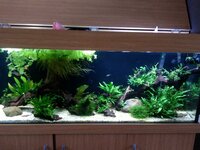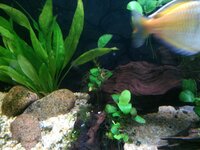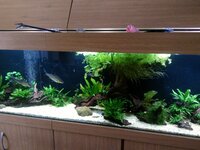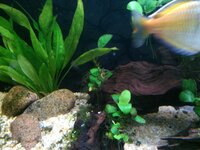Hi, this is my first time posting here. I have a custom made aquarium, it's been running now for about eight years. It's dimensions are length 124 inch height 22 inch depth 18 inch. This tank was built to house my discus fish and back then I had no interest really in plants but since I no longer have the discus my interest in plants has taken off unfortunately for me the plants themselves have not. I was managing to grow some really healthy bba tho, and put this down to my lighting, I was running four 48 inch t8s two on each side of the tank, I have recent replaced them with four fluval fresh and plant 2.0 led's run end to end along the length of the tank. I use easycarbo daily and profito weekly. I do about 33%water change weekly and although I am managing to get rid of the bba I also have a brown algae on some plants which by the way are all slow growing plants java fern, anubias, bucephalandra and some java moss. I know nothing about co2 injection, I wouldn't know where to start. Does anyone here have any ideas why my plants don't grow well.
-
You are viewing the forum as a Guest, please login (you can use your Facebook, Twitter, Google or Microsoft account to login) or register using this link: Log in or Sign Up
You are using an out of date browser. It may not display this or other websites correctly.
You should upgrade or use an alternative browser.
You should upgrade or use an alternative browser.
Should I try to add co2
- Thread starter Plantpot
- Start date
Did the shop recommend these lamps?
They are decent enough but given your tank height, substrate PAR will be (very?) low - fortunately your plants are considered "low" light - the brown algae you're seeing maybe diatoms which are easily cleared by Otocinlus
Most plants will appreciate (gas) CO2 addition - even slow growers such as you've chosen
If you can post tank photos that would help ...
They are decent enough but given your tank height, substrate PAR will be (very?) low - fortunately your plants are considered "low" light - the brown algae you're seeing maybe diatoms which are easily cleared by Otocinlus
Most plants will appreciate (gas) CO2 addition - even slow growers such as you've chosen
If you can post tank photos that would help ...
Thank you for your reply. Yes a shop recommended these lights, a very well known shop. I will post a pic later cos I'm not sure how to do it I will ask my daughter for help. I have a kind of water sprite floating on top of the water can't remember exactly what it is, maybe I should remove it to help with the lighting.
Silviu Man
Member
First of all : don't remove floating plants! That was first thing it caught my eye! Looks perfect, that shadow area looks very well. If you manage to keep it there, over the roots, looks very nice. Many people try to do this and cannot deal with water flow, positioning, etc. Floating plant are helpful in keeping the water clear and in chemical balance of the water too. This because why are strongly recommended especially during cycling time. But it should be kept in a limited shape, is true! Increasing a little the light (maybe using some reflectors) will improuve everything but will help also algae to thrive. What I think is better to do : CO2 addition (in all cases, it help) and, like Plantpot well said, you should use some algae eaters : Amano, Oto, Spiral Horn.
Thanks for that, but what your not seeing in those pics are some quite big angel fish, also some rather large clown loach. I do however have five flying fox algae eaters which have been helping with the bba. I would be scared that Oto, shrimp and snails might be on the menu. The difficulties of adding CO2 I think puts it beyond my capabilities.
Silviu Man
Member
Your right, now I can see the "sharks". Well, this give you not too many natural way to control algae. In this situation, most of the people that like planted aqvarium will say you should make a choice : a clean planted aqvarium with cristal water or ... fish! Use of CO2 helps you in many ways, not only to help plants to thrive. Why looks so difficult to you to use CO2? In 100 litters tank I am using two Tropica 60 (rudimentary system, the cheaper ones) and the tank is going well.
jellyfish6
Member
If you don't like the idea of gas (for whatever reason) you could try liquid carbon.
Silviu Man
Member
One more think : I see in third pictures you use an airstone. Adding CO2, gas or liquid, is useless if you use that airstone. Best way is to have a gently waves on the surface of the water. This way you have a good aeration of water and a longer retention of CO2 in water.
Hi all,
cheers Darrel
You are right, liquid carbon is never a gas so you won't lose it by increasing the gas exchange surface.I didn't think that liquid carbon would be affected by the air stone the way that CO2 is.
cheers Darrel
Silviu Man
Member
As far as I remember from organic chemistry and biology, the only way plants use carbon is in the form of CO2 in combination with inorganic trace minerals for supporting the photosynthesis (Calvin cycle). Then, carbon, in a chemical-liquid form, added in water, should be combind with oxygen, for being highly available to the plants. So the formula is :
C + O2 = CO2
CO2 + H2O = H2CO3 (carbonic acid, that is reversible)
so we have H2CO3 ---> CO2 + H20 and so on ...
So, when liquid carbon is added, for making it available for the plants, carbon need to use the content of oxygen from water for genereting CO2, directly used by plants. CO2 and H2O react, even not very fast, for generating carbonic acid because of low presure (this because why we don't get soda in the tank), but stil form a certain amount of carbonic acid in time, enough to decrease the pH and to keep it at a certain level. This because why pH control need constant addition of CO2. The supplier of liquid carbon recomand that, for the same reason mentioned before and for best results, this should be injected in the proximity of the plant (the clasic exemple is the protection of HC from algae in starting period). Simply adding drops of liquid carbon in water will not make the difference. Eventualy, the best solution is CO2 diffuser with or without liquid supplement of carbon. More than that, all liquid carbon suppliers, strongly recomand a complex of fertilizers used together with liquid carbon, in special formula, for best results.
C + O2 = CO2
CO2 + H2O = H2CO3 (carbonic acid, that is reversible)
so we have H2CO3 ---> CO2 + H20 and so on ...
So, when liquid carbon is added, for making it available for the plants, carbon need to use the content of oxygen from water for genereting CO2, directly used by plants. CO2 and H2O react, even not very fast, for generating carbonic acid because of low presure (this because why we don't get soda in the tank), but stil form a certain amount of carbonic acid in time, enough to decrease the pH and to keep it at a certain level. This because why pH control need constant addition of CO2. The supplier of liquid carbon recomand that, for the same reason mentioned before and for best results, this should be injected in the proximity of the plant (the clasic exemple is the protection of HC from algae in starting period). Simply adding drops of liquid carbon in water will not make the difference. Eventualy, the best solution is CO2 diffuser with or without liquid supplement of carbon. More than that, all liquid carbon suppliers, strongly recomand a complex of fertilizers used together with liquid carbon, in special formula, for best results.
I do already use fertilizers with the easycarbo. I wouldn't have a clue how I would get CO2 to work on my tank, fitting it would I think be impossible. I think I will just leave things as they are for now and hope my new air stone has a positive affect on my my plants, and a negative affect on my algae.
PARAGUAY
Member
Think its a challenge to put pressuried CO2 in such a large tank without a bit of expierence, how about some low to medium requirement stem plants to fill it out.Will help with any algae issue,nice looking tank
Silviu Man
Member
It depends of how much money are available in the budget. There are special diffusers, in the shape of a coil/widing, that ensure a long time retention of the gas. Many others use this, together with a system including a selenoid and a controler. This is the system I will have in a 400 litters tank, conected to the light system. Having this wotking, I will use also liquid CO2 but only to cover the area where I will have plants with high requirements. There is other system that apply the CO2 in the OUT of external filters. There are solutions but ... with a cost!
Hi all,
There is a description in <"CO2, alkalinity and pH">.
We don't actually know the exact pathway by which the plant uses the organic carbon, but there is a discussion of the chemistry in <"How much CO2 does...">, which I think probably covers it.
Have a look at <"Aeration and dissolved oxygen..">, it was written for rheophilic plec keepers, rather than planted tank enthusiasts, but it covers gas exchange.
Most people run an air-stone at night to either:
That is right for the inorganic carbon, assuming you have a source of carbonates (2CO3) the total amount of total inorganic carbon (TIC) remains the same, it just changes in compound. The amount of TIC is dependent upon the atmospheric CO2 concentration.C + O2 = CO2
CO2 + H2O = H2CO3 (carbonic acid, that is reversible)
so we have H2CO3 ---> CO2 + H20 and so on ...
There is a description in <"CO2, alkalinity and pH">.
This is slightly different, we are into the realms of organic carbon and the glutaraldehyde (C5H8O2) isn't ever converted to CO2.So, when liquid carbon is added, for making it available for the plants, carbon need to use the content of oxygen from water for genereting CO2, directly used by plants.
We don't actually know the exact pathway by which the plant uses the organic carbon, but there is a discussion of the chemistry in <"How much CO2 does...">, which I think probably covers it.
You can do either, if you don't add CO2 then a larger gas exchange surface is advantageous in terms of replenishing the CO2 depleted by photosynthesis during the day, but it doesn't make a huge amount of difference.Thank you Darrel would I harm anything if I just leave it on all the time or would it be better just running at night.
Have a look at <"Aeration and dissolved oxygen..">, it was written for rheophilic plec keepers, rather than planted tank enthusiasts, but it covers gas exchange.
Most people run an air-stone at night to either:
- increase the rate of out-gassing of any added CO2 (either as a residue of CO2 injection, or from the repsiring biomass)
- or to add oxygen to the water when plants are net oxygen users (via respiration), rather than net producers (during photosynthesis). It also has the side effect of reducing surface film.
Silviu Man
Member
Yes, you are right! Maybe I was not very clear in my post : the effect of liquid carbon is different than gas addition. Glutaraldehyde is commonly used as disinfectant because of its ability to react with proteins and proteic fractions (amines, amides, ...). In water solution, glutaraldehyde exist in hydrated form, that make it very active against micro-organisms on the surfaces where is applied, especialy combined with quaternary compounds of ammonia. Even in low concentration, glutaraldehyde generate a kind of surfactant effect. A solution of 1% glutaraldehyde will never make drops on a surface, even when surface is greasy (this because why is used also as a fixativ for bacteria, as well as plant and animal samples of tisues in celular biology). Probable this because why, injected directly on the plant, will make the plant to absorb much better tha gases from the water, perhaps by enlarging the stoma of the leaves. Maybe this because why is synergistic with CO2 gas addition, and with other fertilisers. Just put a drop of glutaraldehyde on your finger and see what happens! OK, this is just a speculation, but certainly, is not delivering carbon to the plant system directly but changing something in plant physiology. There are reports regarding the plant dependence on products like Easy Carbo and difficulties of the plants to recover after addition of liquid carbon is stopped. This show a change in morphology and phyziology of the organs of the plant, this is for sure. There are also reports about the "burning" effect of liquid carbon when dossage is exceeded or product is very concetrated on the leaves of the plants. The direct action of glutaraldehyde can explain also the anti-algae effect. I used Easy Carbo, injected on HC that was almost covered with a wadded green algae (I don't remember its name). Algae disappeared in one week. Then after it takes 2-3 weeks for HC to recover and grow again. Sorry if some sentences are not very clear to you, I am not a native speaker of English.






